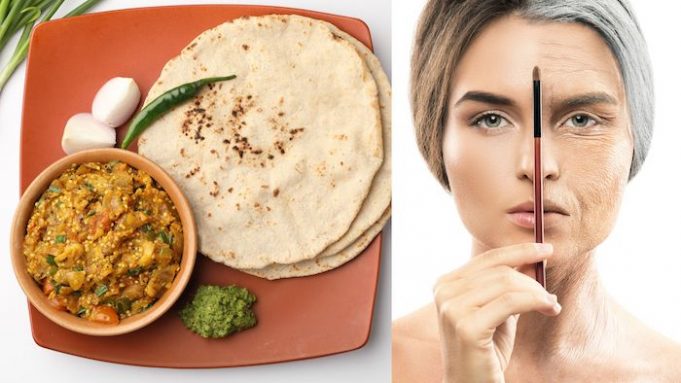Discover the secret to defying age and feeling like you’re in your 20s again! From nutrient-packed superfoods to rejuvenating antioxidants, this eating plan will help you reclaim your youthful glow and vitality. Embrace a new chapter of life with the confidence and vigor of your younger self. It’s time to eat your way to timeless radiance!
- Adequate Protein: Ensure you have an adequate intake of protein from sources like lean meats, fish, dairy products and eggs, legume based proteins like chickpeas, black beans and kidney beans and plant-based proteins like paneer, tofu and tempeh. Protein is essential for muscle repair, immune function, and hormone production.
You can try this Indian balanced meal plan that include a mix of carbohydrates, proteins, healthy fats, and vegetables.
Meal 1: Breakfast
- Vegetable Upma: Made with semolina (rava), mixed vegetables (such as carrots, peas, and bell peppers), and flavored with spices like mustard seeds, curry leaves, and turmeric.
- A side of plain yogurt with a sprinkle of flaxseeds.
- A glass of freshly squeezed orange juice.
Meal 2: Mid-Morning Snack
- A handful of almonds and walnuts.
- A piece of seasonal fruit like an apple or a pear.
Meal 3: Lunch
- Brown rice or whole wheat roti.
- Dal (lentil curry) or a bean-based curry like chana masala.
- A serving of mixed vegetable curry (such as aloo gobi, bhindi masala, or palak paneer).
- A cucumber and tomato salad with a sprinkle of lemon juice and chaat masala.
- A small bowl of curd (yogurt).
Meal 4: Afternoon Snack
- A vegetable or sprout-based salad with a dressing of lemon juice, olive oil, and a pinch of salt.
- A cup of herbal tea or green tea.
Meal 5: Evening Snack
- Roasted chickpeas or a small bowl of sprouts.
- A cup of masala chai or herbal tea.
Meal 6: Dinner
- Quinoa or whole wheat or ragi chapati.
- Grilled paneer tikka (for vegetarians) marinated in yogurt and spices.
- Stir-fried vegetables (such as bell peppers, broccoli, and mushrooms) cooked in olive oil.
- A small bowl of dal or a lentil soup.
- A side of cucumber raita (yogurt with grated cucumber and spices).
- Increase Fiber Intake: Include more fiber-rich foods like fruits, vegetables, whole grains, legumes, and nuts. Fiber aids in digestion, supports heart health, and helps maintain a healthy weight.
- Healthy Fats: Incorporate healthy fats from sources such as walnuts, avocados, almonds, cashews, pumpkin seeds, flaxseeds, olive oil, fatty fish, and coconut oil. These provide essential fatty acids and support heart health, brain function, and hormonal balance.
- Calcium and Vitamin D: Consume foods rich in calcium (dairy products, leafy greens, fortified plant-based milk) and ensure adequate vitamin D intake (exposure to sunlight, fatty fish, fortified foods) for strong bones and teeth.
- Hydration: Stay well-hydrated by drinking plenty of water throughout the day. Limit sugary drinks and opt for herbal teas, infused water, or fresh fruit juices.
- Balanced Meals: Strive for balanced meals that include a mix of carbohydrates, proteins, healthy fats, and vegetables. This helps provide sustained energy and necessary nutrients.
- Colorful Fruits and Vegetables: Aim for a variety of colorful fruits and vegetables to obtain a wide range of vitamins, minerals, antioxidants, and phytochemicals. These help protect against chronic diseases and support overall health.
- Reduce Added Sugars: Minimize the consumption of foods and drinks high in added sugars, such as sodas, sweets, sugary snacks, and processed foods. Opt for natural sweeteners or healthier alternatives like fresh fruits.
- Portion Control: Practice portion control to maintain a healthy weight and prevent overeating. Listen to your body’s hunger and fullness cues.
- Mindful Eating: Pay attention to your eating habits, practice mindful eating, and savor your meals. Avoid distractions like screens while eating and focus on enjoying the flavors and textures of your food.
It’s important to note that there is no one-size-fits-all diet plan that applies universally to everyone after the age of 30. Nutritional needs can vary based on individual factors such as health conditions, activity levels, and personal preferences.
































